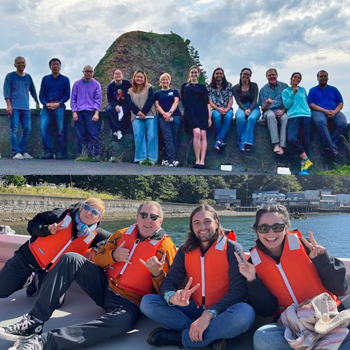
During the week of October 3-10, 2025, the Whitney Laboratory for Marine Bioscience “Cassiopea Crew” in the Martindale Lab traveled to the world renowned Asamushi Research Center for Marine Biology in Aomori, Japan. Their team included postdoctoral researcher (and former graduate student) Dr. Bailey Steinworth and graduate students Cody Miner and Charlotte Kahn, along with principal investigator Dr. Mark Q. Martindale. They were invited by Sensei Dr. Cheryl Ames, Tohoku University, to participate in a workshop on utilizing Cassiopea as a sentinel species for understanding marine animal responses to changing environmental stressors (i.e. climate change) by Japan’s World Premier International Research Center’s Initiative - Advanced Institute for Marine Ecosystem Change (WPI-AIMEC), a ten year project run through Tohoku University and Japan Agency for Marine-Earth Science and Technology (JAMSTEC) in Sendai Japan. Cassiopea is a photosymbiotic animal and a new model for understanding coral reef bleaching. The Whitney team was invited due to their expertise in cell, developmental, and functional genomic advances in this cnidarian system.
Cody led a laboratory session teaching participants how to isolate mesoglea - the collagen-rich extracellular matrix or “jelly” of the jellyfish, in Cassiopea polyps. Though the mesoglea is historically considered to be acellular, in Cassiopea it contains a variety of different cells, including dinoflagellate containing symbiotic cells and what may be a population of innate immune cells. The isolation of the mesoglea in live animals allows for the direct investigation of these as-yet undescribed cells including a thorough singe cell sequencing approach to determine how many distinct cell types reside in the mesoglea, a part of Cody’s dissertation research. Cody led workshop attendees to isolate these mesogleal cells from live polyps and then exposed the captured mesogleal cells to fluorescently labeled bacteria to measure their uptake through phagocytosis.
The rest of the Cassiopea crew presented their work in lectures. Bailey presented her recent publication comparing bud and planula development in Cassiopea and then described her most recent experiments using functional genomic techniques to manipulate gene expression in embryos and polyps by microinjection of fertilized eggs. Charlotte presented her work investigating the origin and proliferation of mesogleal cells. These experiments are important to determine whether mesogleal cells represent a self-renewing population of cells or whether some cell types continue to move in the mesoglea by a process called epithelial to mesenchymal transition (EMT), a process shared by many cells, including cancer cells. Finally, Mark gave a talk on how evolutionary change is constrained and directed by ancestral developmental pathways and processes. Topics for other sessions included regeneration in the hydrozoan jellyfish Cladonema and the sea squirt Ciona, as well as the effects of thermal stress on various scyphozoan jellyfish species.
The goal of this program is to unite researchers with diverse skill sets from around the globe to help understand changes in the marine environment. Whitney made a strong and well received perspective on the use of marine models, and they made a lot of new friends and colleagues on this big adventure.